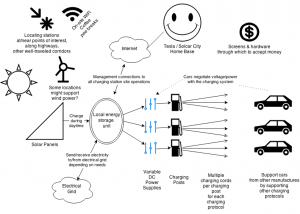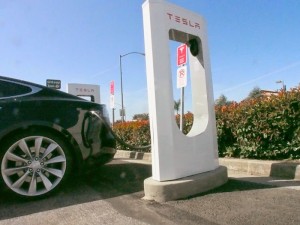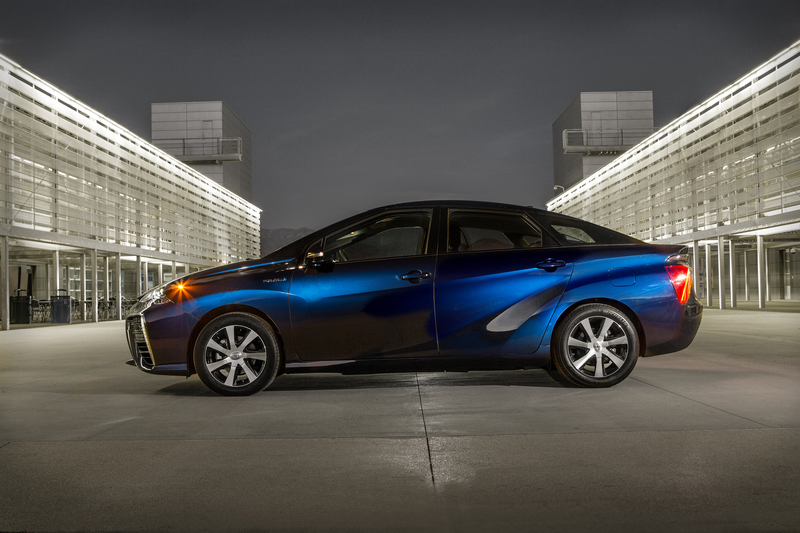Supposedly electric cars pose a risk to stability of the electricity grid. That somehow the electricity grid will be overwhelmed and blow up if every car is switched to electric power. Reuters is reporting today that Toyota’s Chef Engineer for their fuel-cell car, the Mirai, Yoshikazu Tanaka, said that electric cars don’t have a practical future, even if fast charging technology develops, because the fast charging process will kill the electricity grid.
As I’ve noted before, Toyota is clearly clinging to hybrid/gasoline drive systems for current cars, and pushing for fuel cell drive systems in future cars, and downplaying battery-electric drive systems. While the company was an early leader in electrified cars – that is, adding electric drive train components to improve fuel efficiency – they haven’t made the conceptual jump necessary to abandon gasoline. Toyota did start selling the 2nd Generation RAV4 EV, but only in limited numbers (2600 total) with no recourse to build more because they built it on the previous generation RAV4 platform. Toyota is selling the Prius Plug-in Hybrid, but it gets a pathetic 13 miles electric range, and its sales have been falling off. Finally, Toyota sold off their stake in Tesla Motors last fall.
So, just what did Tanaka-san say?
Reuters![]() describes his statement as a fast-charging electric car would “guzzle so much energy at once as to defeat the purpose of the EV as an ecologically sound form of transportation”. Specifically, Reuters quotes Tanaka-san saying “If you were to charge a car in 12 minutes for a range of 500 km (310 miles), for example, you’re probably using up electricity required to power 1,000 houses,” and “That totally goes against the need to stabilize electricity use on the grid.”
describes his statement as a fast-charging electric car would “guzzle so much energy at once as to defeat the purpose of the EV as an ecologically sound form of transportation”. Specifically, Reuters quotes Tanaka-san saying “If you were to charge a car in 12 minutes for a range of 500 km (310 miles), for example, you’re probably using up electricity required to power 1,000 houses,” and “That totally goes against the need to stabilize electricity use on the grid.”
Does this make you scared of electric cars? Maybe that’s his purpose, so that instead you’ll buy one of their fuel cell cars.
Let’s take apart what he’s saying, because it’s actually very wise, spot-on, while being slanted to sell us on fuel cell vehicles.
Charging an electric car with 300+ miles range in 10 minutes or so would equate to the driving range performance of gasoline cars. Obviously that’s roughly similar to a refueling stop at a gas station, and therefore Tanaka-san is one of a long line of people who’ve tried to force-fit battery electric cars into providing the same service.
Today the fastest-charging mass production electric car is the Tesla Model S. At a Supercharger station it can recharge 300ish miles of range in about an hour, or 5x slower than the rate discussed by Tanaka-san. Doing so requires a 120 kiloWatt charging connection. The current CHAdeMO and ComboCharging System infrastructure runs at about 50 kiloWatts (or less) for a somewhat slower effective charging rate than Tesla’s. To charge at 5x the rate of Tesla’s Supercharger, as Tanaka-san suggests, would require 5x the charging current, or a 1 megaWatt charging rate. And, there’s the little matter of battery designs which can absorb charge that quickly without frying.
The generalized rule of thumb is that a “home” runs at 1 kiloWatt, hence 1 megaWatt is about 1,000 homes worth of electricity.
He’s claiming that a ubiquitous network of charging stations, each running at 1 megaWatt, would kill the electricity grid. Is this true?
And, by the way, his solution for that problem is to sell you a fuel cell vehicle.
Let’s spin ourselves into the future about 10-15 years when non-gasoline cars are far more prevalent. Let’s assume battery-electric cars with 12 minute 300+ mile range fast charging do exist. Those future EV owners (whether battery-electric or fuel cell) would want refueling stations of the same model as today’s gasoline stations – a shop along the street where you pop in for a quick charge, a chance to use the bathroom, and perhaps buy some snacks or a magazine. When fully deployed these refueling stations should be as common as today’s gasoline stations.
Yes, if these are battery-electric vehicles the electricity consumption would be pretty large. This would be challenging for the electricity grid operators, maybe. But Tanaka-san’s version assumes a couple things – that there’s no local electricity storage, for example.
I’ve repeatedly heard electricity grid operators say it’ll be a long time before battery electric cars are a problem for the grid, and that they have two concerns at the present time:
- Times of absolute peak electricity load – hot summer afternoons in August when all air conditioners are cranked to 11
- Transformer capacity at the neighborhood level that could trigger the need for transformer upgrades
There is lots and lots of available electricity in the middle of the night. One key to handling lots of electric vehicles is setting up incentives and a system to strongly encourage charging at night.
In any case, I think those same electricity grid operators would say the grid would have difficulty servicing a ubiquitous network of fast charging 1-megaWatt-per-car charging stations servicing a significant number of electric cars.
But, this is solvable simply by doing what gasoline stations do. Gasoline is delivered to gas stations by truck, into a local storage tank, not by pipeline. The electricity equivalent would be to co-locate a large grid-connected energy storage unit. In other words, a very large battery pack that’s connected to the grid and acts as a buffer between charging stations and the grid.
That energy storage unit would have to be capable of supplying a 1 megaWatt charging rate to one or more cars at a time. Its storage capacity (in megaWatt-hours of electricity) would have to be big enough to present a more modest constant load on the electricity grid.
That gasoline tank under every gas station has the same constraints. The tanker truck arrives every day or so to refill the underground storage tank, and in-between those times gasoline is pumped out of that tank. An electricity refueling station, with local grid connected energy storage, has an advantage that the local storage tank doesn’t require sending out a truck full of electricity. The electricity can be delivered over the grid.
 With a large enough energy storage unit, the charging station facility could charge itself at night when electricity is cheap and abundant, then supply it during the day to EV drivers. Further, it’s quite possible to put a solar power canopy over the refueling facility and capture some on-site electricity either for sale to the grid or to directly refill the local energy storage unit.
With a large enough energy storage unit, the charging station facility could charge itself at night when electricity is cheap and abundant, then supply it during the day to EV drivers. Further, it’s quite possible to put a solar power canopy over the refueling facility and capture some on-site electricity either for sale to the grid or to directly refill the local energy storage unit.
With wise technology choices we can have a purely electric driving system that doesn’t kill the electricity grid.
The idea isn’t new – and in fact there are examples of this being developed by companies today.
 Tesla’s plan is that most Supercharger network locations will have co-located solar panels and grid connected energy storage systems. At the time Elon Musk boasted it would be capable of running well beyond the looming Zombie Apocalypse. What he meant by that is the Supercharger locations would be able to run even if completely disconnected from the electricity grid.
Tesla’s plan is that most Supercharger network locations will have co-located solar panels and grid connected energy storage systems. At the time Elon Musk boasted it would be capable of running well beyond the looming Zombie Apocalypse. What he meant by that is the Supercharger locations would be able to run even if completely disconnected from the electricity grid.
Fastned is a charging station network in the Netherlands consisting of facilities along highways, each covered by solar panels.
In February![]() , Imergy Power Systems announced a deal with the Chabot-Las Positas Community College District to set up an “energy island” system on the campus. They already have significant capacity of solar panels on the campus, installed over parking lots. The project will install grid energy storage systems along with energy management systems so that the campus can directly power itself with the on-site solar panels. It won’t be completely independent of the electricity grid, but that one community college will slash its electricity consumption from the grid.
, Imergy Power Systems announced a deal with the Chabot-Las Positas Community College District to set up an “energy island” system on the campus. They already have significant capacity of solar panels on the campus, installed over parking lots. The project will install grid energy storage systems along with energy management systems so that the campus can directly power itself with the on-site solar panels. It won’t be completely independent of the electricity grid, but that one community college will slash its electricity consumption from the grid.
In other words, the technology is here now to co-locate solar panels, wind turbines, etc, and grid-connected electricity storage systems. By doing so you form what’s called a “micro grid” or “energy island” which can power itself from its own electricity without having to touch the electricity grid.
The enabling technologies are energy storage systems and computerized energy management systems.
- Is there enough Grid Capacity for Hydrogen Fuel Cell or Battery Electric cars? - April 23, 2023
- Is Tesla finagling to grab federal NEVI dollars for Supercharger network? - November 15, 2022
- Tesla announces the North American Charging Standard charging connector - November 11, 2022
- Lightning Motorcycles adopts Silicon battery, 5 minute charge time gives 135 miles range - November 9, 2022
- Tesla Autopilot under US Dept of Transportation scrutiny - June 13, 2022
- Spectacular CNG bus fire misrepresented as EV bus fire - April 21, 2022
- Moldova, Ukraine, Georgia, Russia, and the European Energy Crisis - December 21, 2021
- Li-Bridge leading the USA across lithium battery chasm - October 29, 2021
- USA increasing domestic lithium battery research and manufacturing - October 28, 2021
- Electrify America building USA/Canada-wide EV charging network - October 27, 2021






















The one thing you didn’t mention is that many BEVs will be charged at home overnight, where charging speed almost never is an issue. Commercial use would be different but even so I would guess that probably more than 50% percent of charging would be done at slow speeds and at night. Furthermore, with the right real time/online pricing, the massive amount of battery capacity that BEVs will represent could actually help stabilize the grid especially relative to renewables.